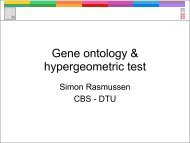Computational tools and Interoperability in Comparative ... - CBS
Computational tools and Interoperability in Comparative ... - CBS
Computational tools and Interoperability in Comparative ... - CBS
Create successful ePaper yourself
Turn your PDF publications into a flip-book with our unique Google optimized e-Paper software.
Funct Integr Genomics (2006) 6: 165–185<br />
DOI 10.1007/s10142-006-0027-2<br />
REVIEW<br />
Tim T. B<strong>in</strong>newies . Yair Motro . Peter F. Hall<strong>in</strong> .<br />
Ole Lund . David Dunn . Tom La . David J. Hampson .<br />
Matthew Bellgard . Trudy M. Wassenaar .<br />
David W. Ussery<br />
Ten years of bacterial genome sequenc<strong>in</strong>g:<br />
comparative-genomics-based discoveries<br />
Received: 20 January 2006 / Revised: 24 February 2006 / Accepted: 7 March 2006 / Published onl<strong>in</strong>e: 12 May 2006<br />
# Spr<strong>in</strong>ger-Verlag 2006<br />
Abstract It has been more than 10 years s<strong>in</strong>ce the first<br />
bacterial genome sequence was published. Hundreds of<br />
bacterial genome sequences are now available for comparative<br />
genomics, <strong>and</strong> search<strong>in</strong>g a given prote<strong>in</strong> aga<strong>in</strong>st<br />
more than a thous<strong>and</strong> genomes will soon be possible. The<br />
subject of this review will address a relatively straightforward<br />
question: “What have we learned from this vast<br />
amount of new genomic data?” Perhaps one of the most<br />
important lessons has been that genetic diversity, at the<br />
level of large-scale variation amongst even genomes of the<br />
same species, is far greater than was thought. The classical<br />
textbook view of evolution rely<strong>in</strong>g on the relatively slow<br />
accumulation of mutational events at the level of <strong>in</strong>dividual<br />
bases scattered throughout the genome has changed. One<br />
of the most obvious conclusions from exam<strong>in</strong><strong>in</strong>g the<br />
sequences from several hundred bacterial genomes is the<br />
enormous amount of diversity—even <strong>in</strong> different genomes<br />
from the same bacterial species. This diversity is generated<br />
by a variety of mechanisms, <strong>in</strong>clud<strong>in</strong>g mobile genetic<br />
elements <strong>and</strong> bacteriophages. An exam<strong>in</strong>ation of the 20<br />
Escherichia coli genomes sequenced so far dramatically<br />
illustrates this, with the genome size rang<strong>in</strong>g from 4.6 to<br />
5.5 Mbp; much of the variation appears to be of phage<br />
orig<strong>in</strong>. This review also addresses mobile genetic elements,<br />
T. T. B<strong>in</strong>newies . P. F. Hall<strong>in</strong> . O. Lund . D. W. Ussery (*)<br />
Center for Biological Sequence Analysis,<br />
Technical University of Denmark,<br />
2800 Lyngby, Denmark<br />
e-mail: dave@cbs.dtu.dk<br />
Y. Motro . D. Dunn . M. Bellgard<br />
Center for Bio<strong>in</strong>formatics <strong>and</strong> Biological Comput<strong>in</strong>g,<br />
Murdoch University,<br />
Murdoch, Western Australia 6150, Australia<br />
T. La . D. J. Hampson<br />
School of Veter<strong>in</strong>ary <strong>and</strong> Biomedical Sciences,<br />
Murdoch University,<br />
Murdoch, Western Australia 6150, Australia<br />
T. M. Wassenaar<br />
Molecular Microbiology <strong>and</strong> Genomics Consultants,<br />
Zotzenheim, Germany<br />
<strong>in</strong>clud<strong>in</strong>g pathogenicity isl<strong>and</strong>s <strong>and</strong> the structure of<br />
transposable elements. There are at least 20 different<br />
methods available to compare bacterial genomes. Metagenomics<br />
offers the chance to study genomic sequences<br />
found <strong>in</strong> ecosystems, <strong>in</strong>clud<strong>in</strong>g genomes of species that are<br />
difficult to culture. It has become clear that a genome<br />
sequence represents more than just a collection of gene<br />
sequences for an organism <strong>and</strong> that <strong>in</strong>formation concern<strong>in</strong>g<br />
the environment <strong>and</strong> growth conditions for the organism<br />
are important for <strong>in</strong>terpretation of the genomic data. The<br />
newly proposed M<strong>in</strong>imal Information about a Genome<br />
Sequence st<strong>and</strong>ard has been developed to obta<strong>in</strong> this<br />
<strong>in</strong>formation.<br />
Keywords Bacterial genomics . <strong>Comparative</strong> genomics .<br />
Bio<strong>in</strong>formatics . Genomic diversity .<br />
Molecular evolution<br />
Introduction<br />
The year 1995 marked the publication of two human<br />
pathogenic bacterial genome sequences: Haemophilus<br />
<strong>in</strong>fluenzae (Fleischmann et al. 1995, US patent number<br />
6,528,289) <strong>and</strong> Mycoplasma genetalium (Fraser et al.<br />
1995, US patent number 6,537,773). S<strong>in</strong>ce then, more than<br />
300 bacterial genomes have been fully sequenced <strong>and</strong><br />
become publicly available, <strong>in</strong>clud<strong>in</strong>g the sequence of a<br />
virulent form of H. <strong>in</strong>fluenzae (Harrison et al. 2005); the<br />
orig<strong>in</strong>al H. <strong>in</strong>fluenzae stra<strong>in</strong> sequenced <strong>in</strong> 1995 was from<br />
an isolate that does not cause disease. Although the<br />
majority of these several hundred genomes are from<br />
pathogenic organisms, some environmental bacterial genome<br />
sequences have also become available. This review<br />
article will provide a brief overview of sequenced bacterial<br />
genomes, their genomic diversity <strong>and</strong> some of the <strong>in</strong>sights<br />
ga<strong>in</strong>ed from analysis of this vast amount of data.<br />
Bacteria are microscopic unicellular prokaryotes that<br />
<strong>in</strong>habit a wide variety of environmental niches, broadly<br />
distributed <strong>in</strong> three ecosystems: the soil, mar<strong>in</strong>e environments<br />
<strong>and</strong> other liv<strong>in</strong>g organisms. Although there are









